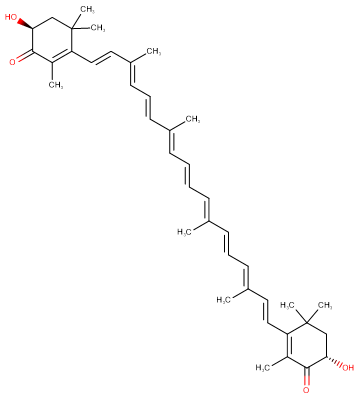
Astaxanthin
CAS No. 472-61-7
Astaxanthin( AstaREAL | AstaXin | BioAstin | Carophyll Pink | Lucantin Pink | NatuRose | Ovoester )
Catalog No. M14570 CAS No. 472-61-7
Astaxanthin is a natural dietary component. Natural astaxanthin is generally recognized as safe (GRAS) by the FDA
Purity : >98% (HPLC)
 COA
COA
 Datasheet
Datasheet
 HNMR
HNMR
 HPLC
HPLC
 MSDS
MSDS
 Handing Instructions
Handing Instructions
| Size | Price / USD | Stock | Quantity |
| 2MG | 27 | In Stock |


|
| 5MG | 39 | In Stock |


|
| 10MG | 55 | In Stock |


|
| 25MG | 88 | In Stock |


|
| 50MG | 120 | In Stock |


|
| 100MG | Get Quote | In Stock |


|
| 200MG | Get Quote | In Stock |


|
| 500MG | Get Quote | In Stock |


|
| 1G | Get Quote | In Stock |


|
Biological Information
-
Product NameAstaxanthin
-
NoteResearch use only, not for human use.
-
Brief DescriptionAstaxanthin is a natural dietary component. Natural astaxanthin is generally recognized as safe (GRAS) by the FDA
-
DescriptionAstaxanthin is a natural dietary component. Natural astaxanthin is generally recognized as safe (GRAS) by the FDA(In Vitro):Astaxanthin (50, 100, 150, 200 μM; 48 h) inhibits the proliferation of DU145 cells (IC50<200 μM).Astaxanthin (200 μM; 24 h) reduces the expression of STAT3 and the related pathway proteins (at both protein and mRNA levels) by inhibiting proliferation, increasing apoptosis and weakening migration and invasionAstaxanthin protects RPE cells from abnormal activation and oxidative stress (induced by high glucose) by down-regulating VEGF in high glucose at protein levels.Astaxanthin (1-50 μM; 72 h) upregulates protein expression of PPARγ in time- and dose-dependent manners in K562 cells.(In Vivo):Astaxanthin (200 mg/kg; intragastric administration; once daily for 3 weeks) inhibits the growth of DU145 tumor xenografts in nude mice.Astaxanthin (125 or 500 mg/kg; in animal feedings; 7 days) provides significant cardioprotection and reduces oxidative stress in rats.
-
In VitroAstaxanthin (50, 100, 150, 200 μM; 48 h) inhibits the proliferation of DU145 cells (IC50<200 μM).Astaxanthin (200 μM; 24 h) reduces the expression of STAT3 and the related pathway proteins (at both protein and mRNA levels) by inhibiting proliferation, increasing apoptosis and weakening migration and invasionAstaxanthin protects RPE cells from abnormal activation and oxidative stress (induced by high glucose) by down-regulating VEGF in high glucose at protein levels.Astaxanthin (1-50 μM; 72 h) upregulates protein expression of PPARγ in time- and dose-dependent manners in K562 cells. Apoptosis Analysis Cell Line:DU145 cells Concentration:200 μM (pre-incubation)Incubation Time:24 h Result:Increased the percentage of apoptotic cells from 8.5% to 13.1% (compared to blank control).Cell Migration Assay Cell Line:DU145 cells Concentration:200 μM Incubation Time:24 hResult:Decreased the migration and invasion of DU145 cells (about 41% of cells could not pass from one chamber to another, and 36% cells could not pass through the transwell membrane as compared to the control group).Cell Proliferation Assay Cell Line:ARPE-19 cells Concentration:50 μM (pre-incubation)Incubation Time:7 days Result:Significantly decreased cell proliferation exposed to high glucose.Western Blot AnalysisCell Line:DU145 cells Concentration:200 μMIncubation Time:24 h Result:Reduced the expression of STAT3 at both protein and mRNA levels (downregulated the protein expression of JAK2, BCL-2 and NF-κB and upregulated the protein expression of BAX, Caspase3 and Caspase9).Western Blot Analysis Cell Line:K562 cellsConcentration:1-50 μM Incubation Time:72 h Result:Significantly promoted PPARγ protein expression in time- and dose-dependent manners.
-
In VivoAstaxanthin (200 mg/kg; intragastric administration; once daily for 3 weeks) inhibits the growth of DU145 tumor xenografts in nude mice.Astaxanthin (125 or 500 mg/kg; in animal feedings; 7 days) provides significant cardioprotection and reduces oxidative stress in rats. Animal Model:Nude mice (approximately 20 g; DU145 tumor xenografts model).Dosage:200 mg/kg Administration:Intragastric administration; once daily for 3 weeks.Result:Exerted a significant inhibitory effect on tumor growth.Animal Model:Female C57BL/6 mice (7 weeks old).Dosage:125 or 500 mg/kg Administration:In animal feedings; 7 days.Result:Significantly reduced mean infarct size in the two treated groups (125 and 500 mg/kg) to 45.1% and 39.1%, respectively.Exhibited myocardial salvage of 26 and 36% for 125 and 500 mg/kg groups, respectively. Significantl reduced level of 9-HETE in a dose-dependent manner. 9-HETE is a regioisomer oxidation product of arachidonic acid believed to be a product of free radical-mediated oxidation.
-
SynonymsAstaREAL | AstaXin | BioAstin | Carophyll Pink | Lucantin Pink | NatuRose | Ovoester
-
PathwayOthers
-
TargetOther Targets
-
RecptorOthers
-
Research AreaOther Indications
-
Indication——
Chemical Information
-
CAS Number472-61-7
-
Formula Weight596.84
-
Molecular FormulaC40H52O4
-
Purity>98% (HPLC)
-
SolubilitySoluble in Chloroform
-
SMILESO=C1C(C)=C(/C=C/C(C)=C/C=C/C(C)=C/C=C/C=C(C)/C=C/C=C(C)/C=C/C2=C(C)C([C@@H](O)CC2(C)C)=O)C(C)(C)C[C@@H]1O
-
Chemical Name(6S)-6-Hydroxy-3-[(1E,3E,5E,7E,9E,11E,13E,15E,17E)-18-[(4S)-4-hydroxy-2,6,6-trimethyl-3-oxo-1-cyclohexenyl]-3,7,12,16-tetramethyloctadeca-1,3,5,7,9,11,13,15,17-nonaenyl]-2,4,4-trimethyl-1-cyclohex-2-enone
Shipping & Storage Information
-
Storage(-20℃)
-
ShippingWith Ice Pack
-
Stability≥ 2 years
Reference
1.Zhang J, et al. J Cell Mol Med. 2015 Sep;19(9):2215-3
molnova catalog



related products
-
Dibutyl carbonate
Dibutyl carbonate
-
NSC139021
NSC139021 is a Rio2 kinase (RIOK2) inhibitor that inhibits ERG protein.
-
Ethyl 2-propylpentan...
Ethyl 2-propylpentanoate (Ethyl valproate) has anticonvulsant activity.



 Cart
Cart
 sales@molnova.com
sales@molnova.com


